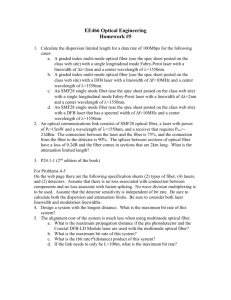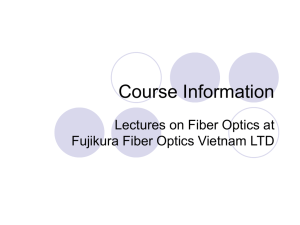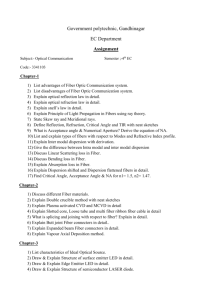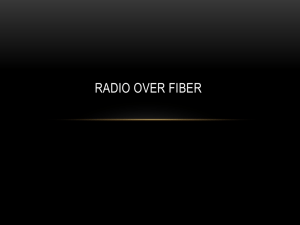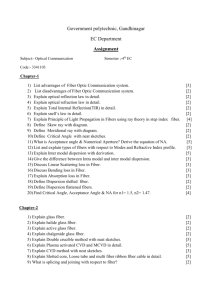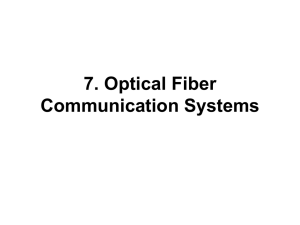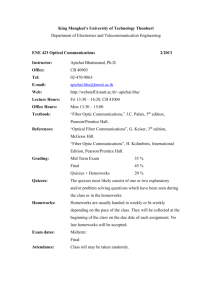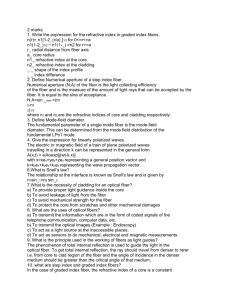EC-703 - Corporate Group of Institutes
advertisement
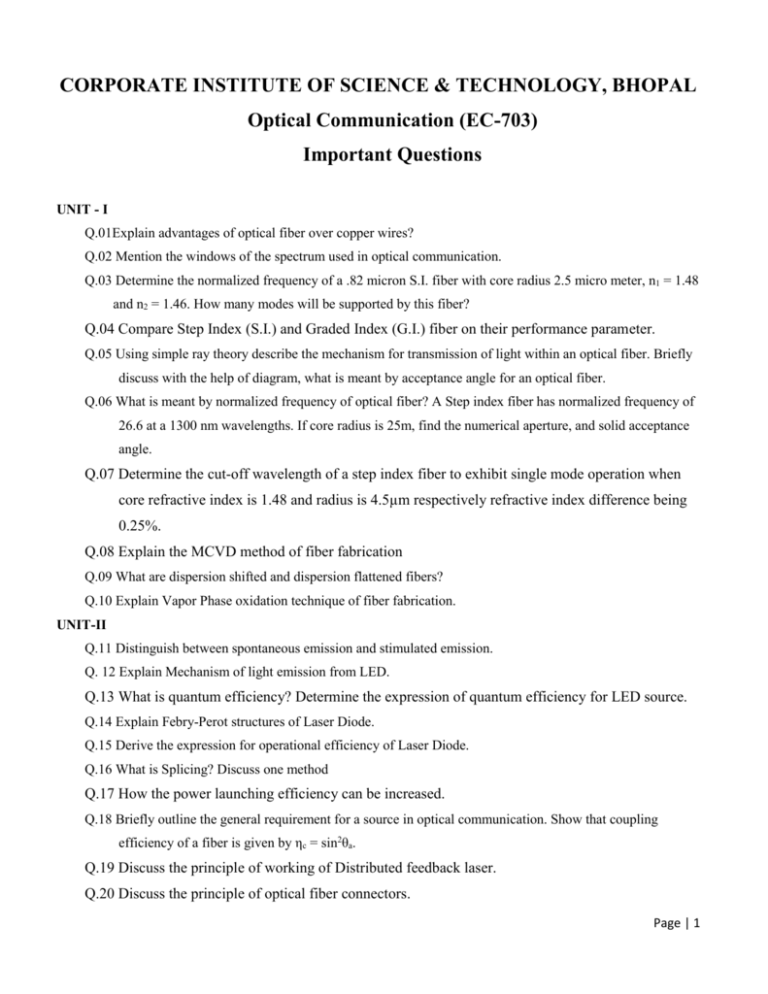
CORPORATE INSTITUTE OF SCIENCE & TECHNOLOGY, BHOPAL Optical Communication (EC-703) Important Questions UNIT - I Q.01Explain advantages of optical fiber over copper wires? Q.02 Mention the windows of the spectrum used in optical communication. Q.03 Determine the normalized frequency of a .82 micron S.I. fiber with core radius 2.5 micro meter, n1 = 1.48 and n2 = 1.46. How many modes will be supported by this fiber? Q.04 Compare Step Index (S.I.) and Graded Index (G.I.) fiber on their performance parameter. Q.05 Using simple ray theory describe the mechanism for transmission of light within an optical fiber. Briefly discuss with the help of diagram, what is meant by acceptance angle for an optical fiber. Q.06 What is meant by normalized frequency of optical fiber? A Step index fiber has normalized frequency of 26.6 at a 1300 nm wavelengths. If core radius is 25m, find the numerical aperture, and solid acceptance angle. Q.07 Determine the cut-off wavelength of a step index fiber to exhibit single mode operation when core refractive index is 1.48 and radius is 4.5µm respectively refractive index difference being 0.25%. Q.08 Explain the MCVD method of fiber fabrication Q.09 What are dispersion shifted and dispersion flattened fibers? Q.10 Explain Vapor Phase oxidation technique of fiber fabrication. UNIT-II Q.11 Distinguish between spontaneous emission and stimulated emission. Q. 12 Explain Mechanism of light emission from LED. Q.13 What is quantum efficiency? Determine the expression of quantum efficiency for LED source. Q.14 Explain Febry-Perot structures of Laser Diode. Q.15 Derive the expression for operational efficiency of Laser Diode. Q.16 What is Splicing? Discuss one method Q.17 How the power launching efficiency can be increased. Q.18 Briefly outline the general requirement for a source in optical communication. Show that coupling efficiency of a fiber is given by ηc = sin2θa. Q.19 Discuss the principle of working of Distributed feedback laser. Q.20 Discuss the principle of optical fiber connectors. Page | 1 UNIT-III Q.21 Explain the threshold condition for Laser diode. Q.22 Describe the working of APD. Q.23 Briefly discuss the different reasons of attenuation in optical fiber. Q.24 Explain Mode Field diameter and Spot size. Q.25 Discuss intermodal and intramodal dispersion in detail. Q.26 Derive Expression for Signal to Noise performance of following (i) Avelanche Photodiode (ii) PIN Photodiode Q.27 Discuss the causes of signal degradation in Optical fibers. Differentiate between material dispersion and waveguide dispersion. Q.28 Explain characteristics of Single mode optical fiber. Q.29 What factors contribute to delay? Also explain what is meant by group delay. Q.30 When 3x1011 photons each with a wavelength of 0.85 µm are incident on a photodiode, on average 1.2x1011 electrons are collected at the terminals of the device. Determine the quantum efficiency and the responsivity of photodiode at 0.85 µm. UNIT-IV Q.31 Discuss the major element of optical receiver. Q.32 Explain the concept of Eye Diagram. Q.33 Discuss homodyne and heterodyne reception. Which one is preferred and why? Q.34 Describe basic coherent detection system. Give its advantages and disadvantages also. Q.35 Write down and explain the link design equation in a point to point communication link based on power budget consideration. Q.36 Describe in detail carrier to noise ratio in analog links. Q.37 Discuss the working of burst mode receiver Q.38 Design fiber link with following specifications Transmitter laser diode Pt= 0 dBm (0 dB →1mW) Two connectors Lc = 1 dB each Fiber splices loss Ls = 0.5 dB each Fiber total loss Lf = 2dB/Km Fiber total dispersion ∆t = 0.505ns/Km Max bit rate B = 35 Mbps. Q.39 Explain in detail the Rise time budget analysis of optical fiber link design. Q.40 Describe the usage of preamplifier and technique for automatic gain control in APD receiver. UNIT-V Q.41 What is WDM. Write down main features. Q.42 Explain Circulators and Isolators. Q.43 Explain working principle of EDFA. Q.44 Describe Optical Power Measurement. Page | 2 Q.45 What is concept of optical performance monitoring. Q.46 Explain Raman amplification in detail Q.47 Discuss power conversion efficiency gain and amplifier noise Q.48 Write short note on Chromatic dispersion compensators Q.49 When 3x1011 photons each with a wavelength of 0.85 µm are incident on a photodiode, on average 1.2x1011 electrons are collected at the terminals of the device. Determine the quantum efficiency and the responsivity of photodiode at 0.85 µm. Q.50 Find the Gain of EDFA in dB if signal o/p is 30 µW. Assume signal input 1 µW. BW and Noise Power of o/p are same. Page | 3



